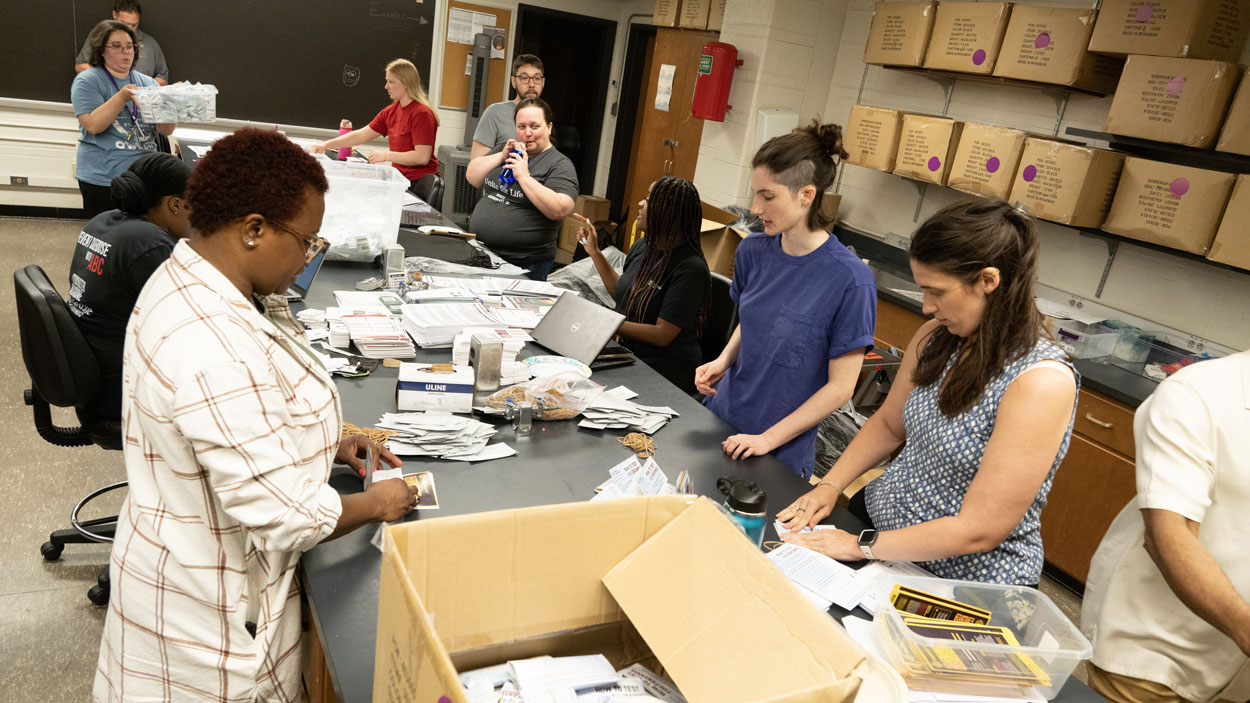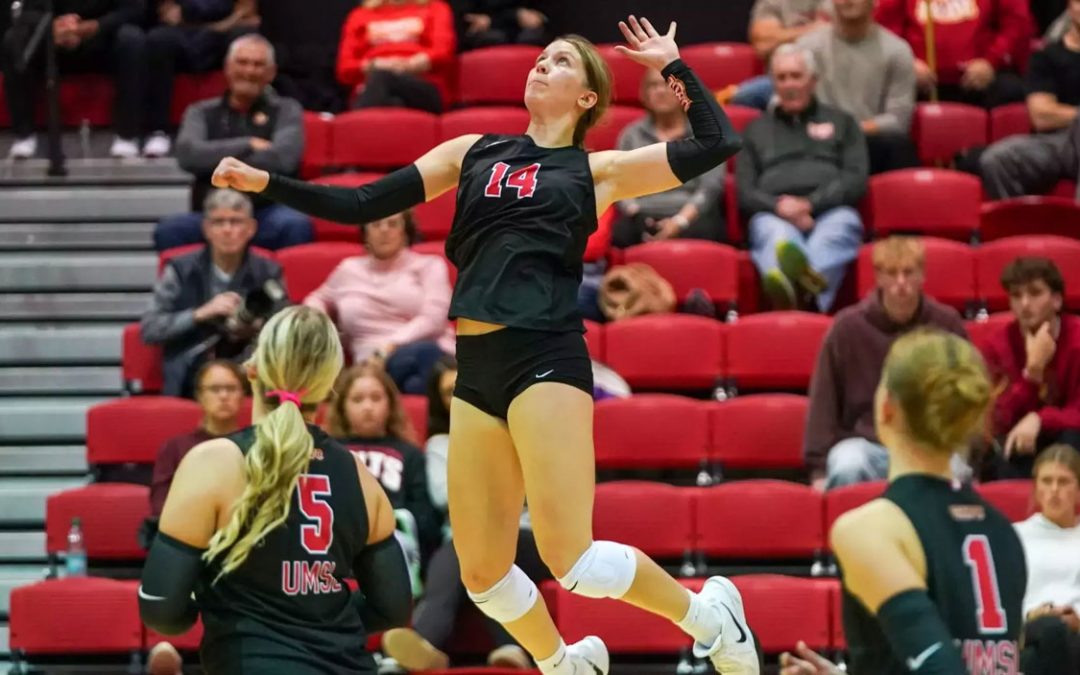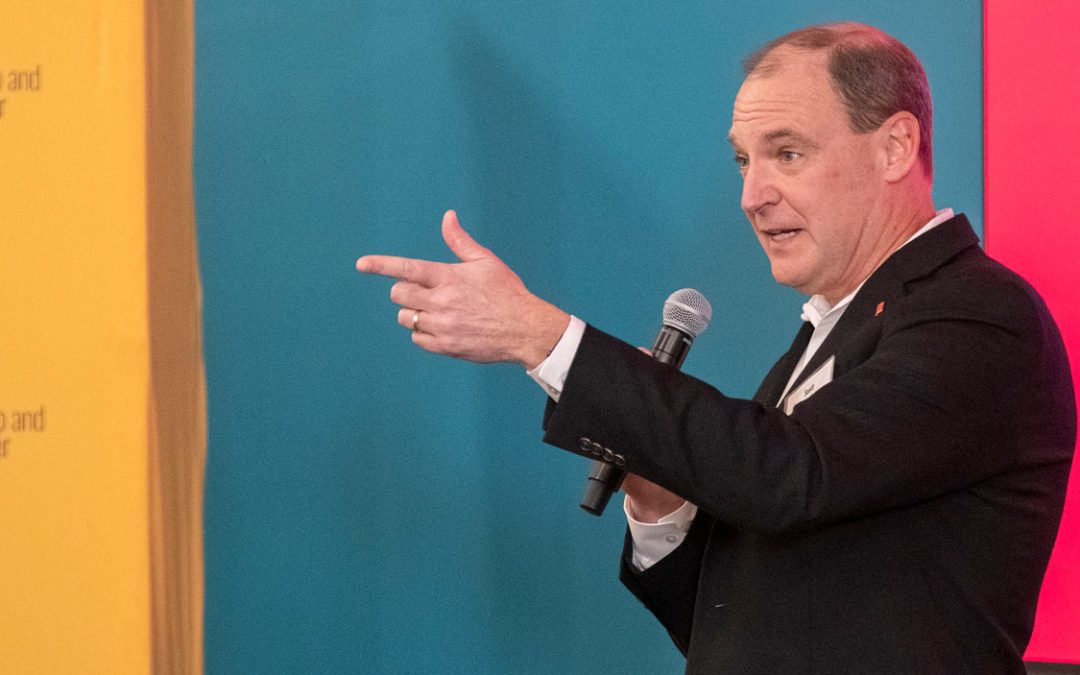
Members of UMSL’s Addiction Science Team assemble overdose prevention kits with doses of naloxone and information about treatment for addiction as part of their efforts to combat the opioid crisis in Missouri and reduce overdose deaths. (Photos by Derik Holtmann)
A new report from the University of Missouri–St. Louis Addiction Science Team showed a 26% decrease in overdose deaths in Missouri from 2023 to 2024, with 1,450 people dying last year compared to 1,948 the year before.
It marks the second year in a row that the state saw a decline in overdose deaths, while the number of opioid-related deaths fell by 36% to its lowest total – 910 – since 2016.

Associate Professor Rachel Winograd leads UMSL’s Addiction Science Team and has been directing statewide efforts to combat the overdose crisis.
Several news outlets were quick to cover the welcome trend, with First Alert 4, Spectrum News and KBIA Radio all publishing stories about the report in the past two weeks. But Rachel Winograd, who leads the Addiction Science Team and holds a dual appointment as an associate professor in UMSL’s Department of Psychological Sciences and Missouri Institute of Mental Health, remains measured in assessing the progress.
“The recent decline in overdose deaths, after years of devastating increases, is encouraging and shows that public health efforts are making a difference,” Winograd said. “But the crisis is far from over. Nearly 1,500 lives were still lost last year in Missouri, and that’s 1,500 too many.
“Beyond the deaths, there are a lot of ways people continue to suffer from our toxic drug supply and the horrible consequences of addiction, so we must continue to strive to reduce that suffering as much as possible.”
But Winograd also knows that there have been times when overdoses seemed to be rising beyond anyone’s control. She was named the principal investigator for the Missouri Opioid/Heroin Overdose Prevention and Education Project in 2016. A year later, she took over as the director of the Missouri Department of Mental Health’s Opioid State Targeted Response project and has spent the past nine years trying to get a handle on the epidemic.
“This progress absolutely gives us hope,” she said.
The Addiction Science Team released its report ahead of the Centers for Disease Control and Prevention’s final estimates for all states, but Missouri’s decline in overdose deaths was similar to or slightly greater than the national average reported in the CDC’s preliminary data (24.5%). Missouri also saw greater declines than in many neighboring states – Nebraska (-2.6%), Iowa (-7.1%), Kansas (-10.8%), Oklahoma (-18.1%), Arkansas (-21.7%), Kentucky (-26.1%), Illinois (-28.2%), and Tennessee (-30.9%) – from 2023 to 2024.
“It’s critical we continue expanding access to overdose prevention, treatment services and recovery supports so this positive momentum keeps up,” Winograd said, “and everyone in Missouri has somewhere to turn.”
She and the Addiction Science Team have been focused on implementing a harm-reduction strategy across the state. Along with improved addiction treatment, a major component of that strategy has been to increase the availability of the drug overdose reversal medication naloxone, including in the hands of first responders across the state.
A separate report from the Addiction Science Team found that statewide naloxone distribution hit a record high, with over 639,000 kits – almost 1.3 million doses and nearly double the previous year – spread throughout Missouri.
“Missouri expanded access to naloxone across the state and made sure people were trained to use it effectively,” Winograd said. “Growth in distribution was fueled by opioid settlement funding and a rapidly expanding network, with our team establishing 515 new partnerships in the past year alone. Low-barrier channels such as mail delivery and vending machines helped us scale quickly.”
There are other factors that could be contributing to the decline, including a modest decrease in the presence of the synthetic opioid fentanyl in the drug supply, which lowers the risk of overdose. The population at highest risk of overdose also appears smaller than in years past, and Winograd said fewer young people appear to be initiating opioid use.
The Addiction Science Team remains committed to reducing overdose deaths even more in the future.
“We are always focused on expanding partnerships and collaborations with community organizations and first responders to ensure that life-saving supplies such as naloxone are widely available and in the hands of those who need it,” Winograd said. “We plan to continue to work with first responders, hospitals, outreach groups, treatment providers and recovery organizations to strengthen referral systems, so someone who survives an overdose has a better chance of connecting with care right away. Collaborative research efforts help us track not only overdose deaths, but also trends in stimulant-related harms, service gaps within systems of care, and outcomes of community health and overdose prevention programs.”
2024 Missouri Drug Overdose Death Report
FY25 Missouri Annual Naloxone Report
Media Coverage
First Alert 4
Spectrum News
KBIA














